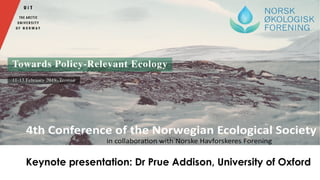
Dr Prue Addison, Keynote Presentation, Norwegian Ecological Society Conference 2019
- 1. Keynote presentation: Dr Prue Addison, University of Oxford
- 2. @prueaddison Dr Prue Addison Knowledge Exchange & Research Fellow Applying the output from ecological science into decision-making
- 3. 3
- 6. 6
- 7. 7 The decision context for the Victorian coastline Considered but not adequately consulted about our research
- 8. 8 “Despite the aligned aspirations of many applied scientists and policy-makers that science should contribute directly to policy decisions, there are significant gaps between what scientists provide and what policymakers can use.” Burgman. 2015. Asia & the Pacific Policy Studies. 2. 441-451
- 9. 9 Evidence used in Protected Area management
- 10. 10 Cook, et al. 2010. Front Ecol Environ 8: 181-186 Evidence used in Protected Area management
- 11. 11 Cook, et al. 2010. Front Ecol Environ 8: 181-186 Evidence used in Protected Area management
- 12. Rethinking the ‘evidence-based’ mindset 12 1. Reject ‘evidence-based’ mindset 2. Think ‘evidence-informed’ Rose, 2014. Nature Climate Change 4: 522.
- 13. 13 Knowledge Exchange: an emerging discipline
- 15. 15 About me… … after my time as a marine ecologist
- 16. 16 Science Practice • Developing decision support tools for MPA managers • Developing decision support tools for catchment policy-makers and managers • Developing guidance and decision support for businesses wanting to integrate biodiversity into management & reporting
- 17. 17 5 critical factors for achieving research impact
- 18. 1: Build & maintain networks 18
- 19. 2: Develop collaborative partnerships 19 Research Practice
- 20. 20 Cvitanovic et al. 2015. Ocean & Coastal Management 112: 25-35. 2: Develop collaborative partnerships
- 21. 21 Research Councils UK, Pathways to Impact • Passion • Communication • Trust • Power 3: Master social dynamics
- 22. 22 4: Seek institutional support Cvitanovic et al. 2019. Environmental Science & Policy. 94: 20-31
- 23. 23 Creating a New Kind of Science in Academia Produce not only professors but also future environmental leaders Keeler et al, 2017. BioScience, 67: 591-592 4: Seek institutional support
- 24. 5: Evaluate & learn 24 Knight et al (in prep) Knowledge exchange process Changes to understanding Policy or practice change Impacts of policy or practice change Extent of control over that being evaluated Extent of real world impact
- 25. 25 5 critical factors for achieving research impact 1: Build & maintain networks 2: Develop collaborative partnerships 3: Master social dynamics 4: Seek institutional support 5: Evaluate and learn
- 26. 26 A process to integrate science into decision-making
- 27. 27Source: https://www.mpls.ox.ac.uk/public-engagement/what-is-public-engagement A method to support co-production:
- 28. Structured decision-making — Framework, concept, & community of practice — Based on decision theory and risk assessment — Collaboration of natural resource scientists and managers — Creates good decision-making processes rather than good outcomes 28 Addison et al. 2013. Diversity and Distributions. 19: 490–502
- 29. Structured decision-making helps when 29 Navigating complex environmental decisions: — Multiple competing objectives — Multiple stakeholders with different perspectives (values) — Uncertainty & risk = Difficult to work out what the best (optimal) solution
- 30. Promotes the incorporation of scientific facts and values into decisions, acknowledging that decision-making is not a value free process 30 Incorporates scientific facts and human values Economic Social Environmental Facts Values © AIMS
- 31. 31
- 32. 32 A participatory modelling approach to set management thresholds Mean%cover Current population Management threshold Addison et al. 2015. Conservation Biology. 29, 1411–1422